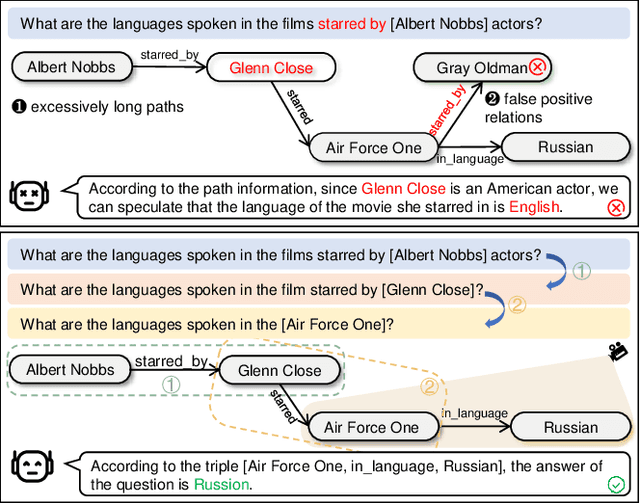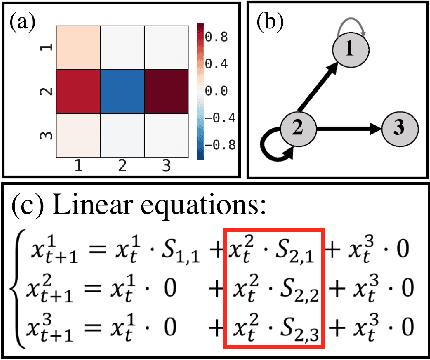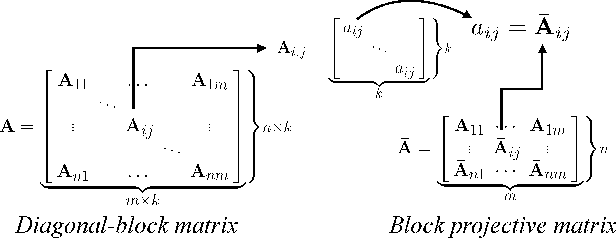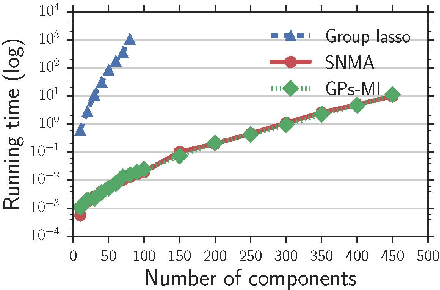Hongbin Pei
Attribution Explanations for Deep Neural Networks: A Theoretical Perspective
Aug 11, 2025Abstract:Attribution explanation is a typical approach for explaining deep neural networks (DNNs), inferring an importance or contribution score for each input variable to the final output. In recent years, numerous attribution methods have been developed to explain DNNs. However, a persistent concern remains unresolved, i.e., whether and which attribution methods faithfully reflect the actual contribution of input variables to the decision-making process. The faithfulness issue undermines the reliability and practical utility of attribution explanations. We argue that these concerns stem from three core challenges. First, difficulties arise in comparing attribution methods due to their unstructured heterogeneity, differences in heuristics, formulations, and implementations that lack a unified organization. Second, most methods lack solid theoretical underpinnings, with their rationales remaining absent, ambiguous, or unverified. Third, empirically evaluating faithfulness is challenging without ground truth. Recent theoretical advances provide a promising way to tackle these challenges, attracting increasing attention. We summarize these developments, with emphasis on three key directions: (i) Theoretical unification, which uncovers commonalities and differences among methods, enabling systematic comparisons; (ii) Theoretical rationale, clarifying the foundations of existing methods; (iii) Theoretical evaluation, rigorously proving whether methods satisfy faithfulness principles. Beyond a comprehensive review, we provide insights into how these studies help deepen theoretical understanding, inform method selection, and inspire new attribution methods. We conclude with a discussion of promising open problems for further work.
Deliberation on Priors: Trustworthy Reasoning of Large Language Models on Knowledge Graphs
May 21, 2025Abstract:Knowledge graph-based retrieval-augmented generation seeks to mitigate hallucinations in Large Language Models (LLMs) caused by insufficient or outdated knowledge. However, existing methods often fail to fully exploit the prior knowledge embedded in knowledge graphs (KGs), particularly their structural information and explicit or implicit constraints. The former can enhance the faithfulness of LLMs' reasoning, while the latter can improve the reliability of response generation. Motivated by these, we propose a trustworthy reasoning framework, termed Deliberation over Priors (DP), which sufficiently utilizes the priors contained in KGs. Specifically, DP adopts a progressive knowledge distillation strategy that integrates structural priors into LLMs through a combination of supervised fine-tuning and Kahneman-Tversky optimization, thereby improving the faithfulness of relation path generation. Furthermore, our framework employs a reasoning-introspection strategy, which guides LLMs to perform refined reasoning verification based on extracted constraint priors, ensuring the reliability of response generation. Extensive experiments on three benchmark datasets demonstrate that DP achieves new state-of-the-art performance, especially a Hit@1 improvement of 13% on the ComplexWebQuestions dataset, and generates highly trustworthy responses. We also conduct various analyses to verify its flexibility and practicality. The code is available at https://github.com/reml-group/Deliberation-on-Priors.
Debate on Graph: a Flexible and Reliable Reasoning Framework for Large Language Models
Sep 05, 2024
Abstract:Large Language Models (LLMs) may suffer from hallucinations in real-world applications due to the lack of relevant knowledge. In contrast, knowledge graphs encompass extensive, multi-relational structures that store a vast array of symbolic facts. Consequently, integrating LLMs with knowledge graphs has been extensively explored, with Knowledge Graph Question Answering (KGQA) serving as a critical touchstone for the integration. This task requires LLMs to answer natural language questions by retrieving relevant triples from knowledge graphs. However, existing methods face two significant challenges: \textit{excessively long reasoning paths distracting from the answer generation}, and \textit{false-positive relations hindering the path refinement}. In this paper, we propose an iterative interactive KGQA framework that leverages the interactive learning capabilities of LLMs to perform reasoning and Debating over Graphs (DoG). Specifically, DoG employs a subgraph-focusing mechanism, allowing LLMs to perform answer trying after each reasoning step, thereby mitigating the impact of lengthy reasoning paths. On the other hand, DoG utilizes a multi-role debate team to gradually simplify complex questions, reducing the influence of false-positive relations. This debate mechanism ensures the reliability of the reasoning process. Experimental results on five public datasets demonstrate the effectiveness and superiority of our architecture. Notably, DoG outperforms the state-of-the-art method ToG by 23.7\% and 9.1\% in accuracy on WebQuestions and GrailQA, respectively. Furthermore, the integration experiments with various LLMs on the mentioned datasets highlight the flexibility of DoG. Code is available at \url{https://github.com/reml-group/DoG}.
Look, Listen, and Answer: Overcoming Biases for Audio-Visual Question Answering
Apr 18, 2024



Abstract:Audio-Visual Question Answering (AVQA) is a complex multi-modal reasoning task, demanding intelligent systems to accurately respond to natural language queries based on audio-video input pairs. Nevertheless, prevalent AVQA approaches are prone to overlearning dataset biases, resulting in poor robustness. Furthermore, current datasets may not provide a precise diagnostic for these methods. To tackle these challenges, firstly, we propose a novel dataset, \textit{MUSIC-AVQA-R}, crafted in two steps: rephrasing questions within the test split of a public dataset (\textit{MUSIC-AVQA}) and subsequently introducing distribution shifts to split questions. The former leads to a large, diverse test space, while the latter results in a comprehensive robustness evaluation on rare, frequent, and overall questions. Secondly, we propose a robust architecture that utilizes a multifaceted cycle collaborative debiasing strategy to overcome bias learning. Experimental results show that this architecture achieves state-of-the-art performance on both datasets, especially obtaining a significant improvement of 9.68\% on the proposed dataset. Extensive ablation experiments are conducted on these two datasets to validate the effectiveness of the debiasing strategy. Additionally, we highlight the limited robustness of existing multi-modal QA methods through the evaluation on our dataset.
Robust Visual Question Answering: Datasets, Methods, and Future Challenges
Jul 21, 2023Abstract:Visual question answering requires a system to provide an accurate natural language answer given an image and a natural language question. However, it is widely recognized that previous generic VQA methods often exhibit a tendency to memorize biases present in the training data rather than learning proper behaviors, such as grounding images before predicting answers. Therefore, these methods usually achieve high in-distribution but poor out-of-distribution performance. In recent years, various datasets and debiasing methods have been proposed to evaluate and enhance the VQA robustness, respectively. This paper provides the first comprehensive survey focused on this emerging fashion. Specifically, we first provide an overview of the development process of datasets from in-distribution and out-of-distribution perspectives. Then, we examine the evaluation metrics employed by these datasets. Thirdly, we propose a typology that presents the development process, similarities and differences, robustness comparison, and technical features of existing debiasing methods. Furthermore, we analyze and discuss the robustness of representative vision-and-language pre-training models on VQA. Finally, through a thorough review of the available literature and experimental analysis, we discuss the key areas for future research from various viewpoints.
Curvature Regularization to Prevent Distortion in Graph Embedding
Nov 28, 2020



Abstract:Recent research on graph embedding has achieved success in various applications. Most graph embedding methods preserve the proximity in a graph into a manifold in an embedding space. We argue an important but neglected problem about this proximity-preserving strategy: Graph topology patterns, while preserved well into an embedding manifold by preserving proximity, may distort in the ambient embedding Euclidean space, and hence to detect them becomes difficult for machine learning models. To address the problem, we propose curvature regularization, to enforce flatness for embedding manifolds, thereby preventing the distortion. We present a novel angle-based sectional curvature, termed ABS curvature, and accordingly three kinds of curvature regularization to induce flat embedding manifolds during graph embedding. We integrate curvature regularization into five popular proximity-preserving embedding methods, and empirical results in two applications show significant improvements on a wide range of open graph datasets.
Geom-GCN: Geometric Graph Convolutional Networks
Feb 14, 2020



Abstract:Message-passing neural networks (MPNNs) have been successfully applied to representation learning on graphs in a variety of real-world applications. However, two fundamental weaknesses of MPNNs' aggregators limit their ability to represent graph-structured data: losing the structural information of nodes in neighborhoods and lacking the ability to capture long-range dependencies in disassortative graphs. Few studies have noticed the weaknesses from different perspectives. From the observations on classical neural network and network geometry, we propose a novel geometric aggregation scheme for graph neural networks to overcome the two weaknesses. The behind basic idea is the aggregation on a graph can benefit from a continuous space underlying the graph. The proposed aggregation scheme is permutation-invariant and consists of three modules, node embedding, structural neighborhood, and bi-level aggregation. We also present an implementation of the scheme in graph convolutional networks, termed Geom-GCN (Geometric Graph Convolutional Networks), to perform transductive learning on graphs. Experimental results show the proposed Geom-GCN achieved state-of-the-art performance on a wide range of open datasets of graphs. Code is available at https://github.com/graphdml-uiuc-jlu/geom-gcn.
Group Sparse Bayesian Learning for Active Surveillance on Epidemic Dynamics
Nov 21, 2017



Abstract:Predicting epidemic dynamics is of great value in understanding and controlling diffusion processes, such as infectious disease spread and information propagation. This task is intractable, especially when surveillance resources are very limited. To address the challenge, we study the problem of active surveillance, i.e., how to identify a small portion of system components as sentinels to effect monitoring, such that the epidemic dynamics of an entire system can be readily predicted from the partial data collected by such sentinels. We propose a novel measure, the gamma value, to identify the sentinels by modeling a sentinel network with row sparsity structure. We design a flexible group sparse Bayesian learning algorithm to mine the sentinel network suitable for handling both linear and non-linear dynamical systems by using the expectation maximization method and variational approximation. The efficacy of the proposed algorithm is theoretically analyzed and empirically validated using both synthetic and real-world data.
 Add to Chrome
Add to Chrome Add to Firefox
Add to Firefox Add to Edge
Add to Edge